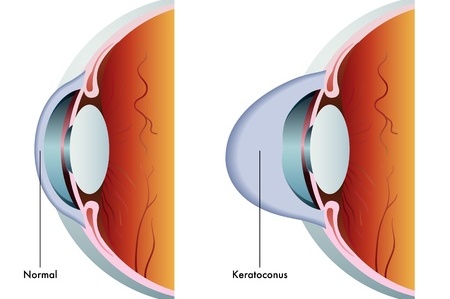Wishing everyone a safe and happy Christmas and New Year – Meri Kirihimete from the Healthify team.
Keratoconus
Key points about keratoconus
- Keratoconus is an eye condition affecting the front clear window of your eye (cornea).
- The cornea becomes thinner and irregular in shape which affects your vision.
- Early symptoms can be slight blurring or distortion of vision even when you're wearing glasses or contact lenses. Other symptoms include increased sensitivity to glare and light .
- Keratoconus can eventually progress to severe vision loss.
- Treatment depends on the severity of the condition and ranges from glasses or contacts through to surgery.

Keratoconus is an eye condition that affects the front clear window of your eye (the cornea).
The shape of your cornea changes from its normal round shape to an irregular cone shape and this affects your vision. Your cornea gets thinner and your eye bulges out.
The cornea is the transparent front surface of your eye. If you have keratoconus, the cornea becomes thinned, distorted and irregular (cone shaped) and your eye bulges out. The shape of your cornea prevents the light entering your eye from being focused correctly on the retina at the back of your eye and distorts your vision.
 Image credit: 123rf
Image credit: 123rf
Keratoconus is usually seen in people who are very near-sighted and who have astigmatism. Though some can also be long sighted.
The changes and symptoms usually start in your early teens and can get worse in your 30s. It’s a progressive condition which can develop quickly, or can take many years to become apparent. It commonly affects both eyes, although sometimes only one eye is affected.
The cause of keratoconus isn’t fully understood, but genetics may play a part as it does run in some families.
Keratoconus is known to be associated with eye rubbing. Allergic eye conditions and keratoconus are frequently seen together.
Early symptoms of keratoconus include:
- blurred vision – even when you're wearing glasses or contact lenses
- distorted vision – where objects can look warped
- increased sensitivity to light and glare.
Both eyes can be affected, but you may have different symptoms in each eye.
Later (usually over several months to years) you may experience:
- increased blurriness and distorted vision
- altered refraction (focus error) especially increasing astigmatism (a condition where your eye is oval shaped instead of evenly rounded), meaning your glasses can lose their helpfulness more quickly than usual
- not being able to wear regular contact lenses because they don’t fit properly anymore.
Keratoconus can occasionally change rapidly when your cornea becomes very thin. See a doctor immediately if you have any of these symptoms or signs:
- Sudden onset of severely blurred vision.
- Severe light sensitivity, redness and pain.
If you’re concerned that you might have keratoconus, it’s important to see your healthcare provider or an optometrist for an eye examination. They will do some initial tests and can help work out what's causing your vision to be blurry.
After these tests, you may need more detailed testing by an optometrist and/or an eye surgeon (ophthalmologist). This may include a corneal topography test to assess the shape of your cornea and look for swelling or scarring.
Read more about eye examinations.
Treatment of keratoconus depends on its stage and severity.
Visual enhancement with glasses or contact lenses
Usually, your vision can be corrected using glasses or contact lenses. There are different types of contact lenses that your optometrist can advise you about. A government subsidy may be available to help with the costs of contact lenses. Ask your eye specialist for more information about this.
Surgery
Sometimes surgery may be recommended if your keratoconus is progressing. A procedure called corneal cross-linking is available to slow down or stop its progression. If your condition is severe, and your vision doesn’t improve sufficiently with visual aids, corneal transplant surgery may be of benefit. This has been used successfully for many years and can restore significant visual function. Your eye specialist will recommend the best procedure for you.
If you have keratoconus it's most important to avoid rubbing your eyes. Rubbing can damage your cornea and make your symptoms worse. It is therefore critical to have your allergies controlled. Talk to your healthcare provider about medicines to control allergies.
Apps reviewed by Healthify
You may find it useful to look at some Vision difficulty apps.
Most people with keratoconus have better vision with contact lens treatment.
Although corneal transplant is generally successful, there is a significant risk involved. If you are privileged to be offered a corneal transplant, you must follow the recommended care and attend all future appointments to ensure long term success and maintenance of your vision. The post-operative recovery can take some time and you may still need to wear glasses or contact lenses to optimise your vision afterwards.
Laser refractive surgery for vision correction is contraindicated for people with keratoconus.
Keratoconus(external link) Auckland Eye, NZ
Keratoconus NZ(external link)
Apps
References
- Keratoconus(external link) MedlinePlus, US, 2022
- Keratoconus(external link) Auckland Eye, NZ
- What is keratoconus?(external link) American Academy of Ophthalmology, US, 2023
- Keratoconus(external link) Cleveland Clinic, US, 2023
Angelo L, Gokul A. Current state of keratoconus management in New Zealand(external link) New Zealand Optics, 2024
Credits: Healthify editorial team. Healthify is brought to you by Health Navigator Charitable Trust. Content adapted with permission from The Auckland Eye Manual.
Reviewed by: Dr Chi-Ying Chou, Ophthalmologist, Auckland Eye
Last reviewed:





